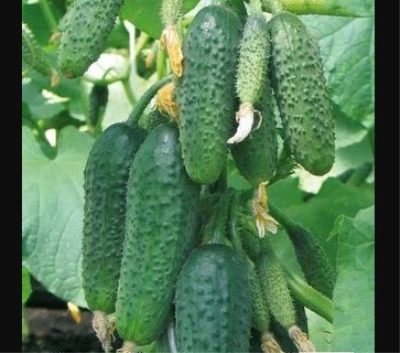
- Authors: Suddenko V.G., Borisov A.V., Krylov O.N., Skachko V.A., LLC Selection and seed-growing company 'MANUL'
- Year of approval: 2009
- Growth type: indeterminate
- Branching: strong
- Fruit weight, g: 115
- Fruit length, cm: 8-13
- Fruit color: green with short stripes
- Cucumber Mosaic Virus Resistance: stable
- Ripening terms: early
- Fruit shape: oval, slightly ribbed
Bogatyrskaya power is a salad variety of cucumbers, developed by the selection and seed-growing company "Manul". The variety has been approved for use since 2009. Let's take a closer look at the features of this hybrid.
Description of the variety
Heroic strength is a plant that does not require pollination. The hybrid is able to self-pollinate even in case of disease. This vegetable is allowed to grow both in the open air and under a film greenhouse. Additional features are high productivity and long growing season, that is, the culture bears fruit until the onset of autumn.
Characteristics of the appearance of plants and zelents
The bush is of the indeterminate type, it has strong branching and green, medium-sized leaves. The variety belongs to bunch varieties and forms from 2-4 to 6-8 zelents in one bunch. Also, the bush is characterized by active regrowth of lateral shoots.
Fruits are formed short, only 8-13 cm long and weighing about 115 g. Zelentsy have an oval shape and green, with short lines, mid-tuberous skin. The undoubted advantage of the fruits is their high marketability.
Purpose and taste of fruits
Summer residents note the excellent taste of the fruit without bitterness. Their pulp is juicy, aromatic, of medium density. Cucumbers can be used fresh, and the dense skin allows them to be used for pickling or preservation.
Maturation
Heroic strength belongs to varieties with an early ripening period, that is, the taste of the first cucumbers can be appreciated already 40 days after the first shoots hatch.
Yield
This is a fairly productive variety that is able to please the owner of the plot with a harvest of 13 kg per square meter.
Landing scheme
Sowing is carried out in April-May, and if the seeds are planted immediately in open ground, then the period is shifted to May-June. When cultivated in central Russia, seedlings are transplanted into open ground during June 1-5, in the southern regions the procedure is carried out earlier, in April-May. If the seedlings are planted under a film, then the optimal time for this is May 15-20.
When choosing a site for a vegetable of the presented variety, give preference to ridges located in the sun. Plant seedlings in a greenhouse at 2.5 per 1 sq. m, and in the open field - 3-5 bushes per 1 square meter.
Growing and caring
It is a moisture-loving variety, it reacts especially well to moisture at the stage of fruit ripening. For watering, use warm, settled water and perform the procedure in the evening or in the morning as the soil dries out. For each square meter, 5-10 liters of water will be required, and with the beginning of ripening - up to 20 liters.
After flowering, the crop needs fertilization. As a nutritional supplement, complex mineral compositions or natural remedies, for example, manure or chicken droppings, can be applied at the root. Before the fruits ripen, the culture is sprayed on the leaf with a solution of urea.
As the bushes grow, they are tied to supports and trellises and pinching is carried out.

In order to collect strong, tasty and beautiful cucumbers on your site, you need to make top dressing. Lack of nutrients can negatively affect the appearance of the plant and significantly reduce the yield. Fertilize cucumbers with organic fertilizers in combination with mineral fertilizers. With the right balance of these components and adherence to the fertilizing schedule, the cucumber yield will be maximum.
Disease and pest resistance
The presented variety is resistant to the cucumber mosaic virus and cladosporiosis, and is also tolerant to powdery mildew and downy mildew, that is, it can be affected by these diseases, but it will continue to yield crops, the damage from the defeat will be small.
Nevertheless, the plant needs preventive measures, especially since there will be no special problems with this. At least once a season, treat the crop with special equipment, keep the area clean, regularly inspect the plant for signs of disease and loosen the soil once a week after watering, and remove weeds in a timely manner. As a pest prevention, plant marigolds next to the cucumbers: insects are afraid of their smell.

Despite their popularity, cucumbers are often attacked by diseases and pests. From them, cucumber plantings often die before the start of fruiting. In order to prevent this from happening, it is necessary to try to prevent ailments or get rid of them at the very beginning, having studied in detail their causes of occurrence, signs and methods of treatment.





























































































